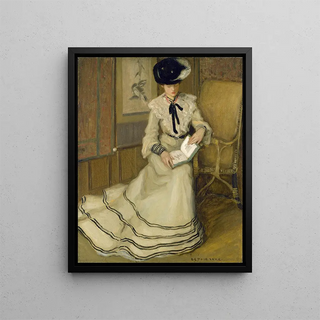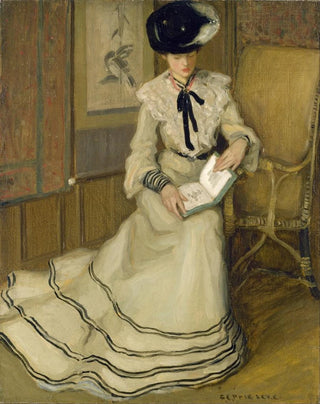Art print | Girl reading - Frederick Carl Frieseke


View from behind

Frame (optional)
In the world of art, certain works manage to capture the very essence of everyday life while evoking deep intimacy. "Fille lisant - Frederick Carl Frieseke" is one of those creations that, through its apparent simplicity, reveals emotional richness and a delicate atmosphere. This piece, created in the early 20th century, immerses the viewer in a suspended moment, where time seems to stand still around the young girl absorbed in her reading. The soft light illuminating the scene creates a serene ambiance, inviting contemplation and escape. Through this art print, one is transported to a universe where the book becomes the vessel of a shared dream between the artist and their audience.
Style and uniqueness of the work
Frieseke's style is distinguished by its impressionist approach, characterized by light brushstrokes and a pastel color palette. In "Fille lisant," the way he renders natural light is simply enchanting. Every detail, from the reflections on the pages of the book to the gentle shadows cast by the light, is treated with meticulous care that demonstrates his craftsmanship. The artist manages to create an intimate atmosphere, where each element of the composition, from the furniture to the posture of the young girl, contributes to telling a silent story. The delicacy of textures and the fluidity of forms invite the viewer to feel the tranquility of this reading moment, evoking gentle melancholy and nostalgia for the simple pleasures of life.
The artist and his influence
Frederick Carl Frieseke, originally from the United States, established himself on the European art scene in the early 20th century, notably in Giverny, where he mingled with masters such as Claude Monet. His work reflects a constant dialogue between Impressionism and a more personal approach, where the motif of the woman, often depicted in moments of solitude or reflection, takes a central place. Frieseke captured the essence of modernity while remaining rooted in artistic traditions. His influence is evident in the work of many contemporary artists who seek to explore light and intimacy through scenes of everyday life.

Matte finish

View from behind

Frame (optional)
In the world of art, certain works manage to capture the very essence of everyday life while evoking deep intimacy. "Fille lisant - Frederick Carl Frieseke" is one of those creations that, through its apparent simplicity, reveals emotional richness and a delicate atmosphere. This piece, created in the early 20th century, immerses the viewer in a suspended moment, where time seems to stand still around the young girl absorbed in her reading. The soft light illuminating the scene creates a serene ambiance, inviting contemplation and escape. Through this art print, one is transported to a universe where the book becomes the vessel of a shared dream between the artist and their audience.
Style and uniqueness of the work
Frieseke's style is distinguished by its impressionist approach, characterized by light brushstrokes and a pastel color palette. In "Fille lisant," the way he renders natural light is simply enchanting. Every detail, from the reflections on the pages of the book to the gentle shadows cast by the light, is treated with meticulous care that demonstrates his craftsmanship. The artist manages to create an intimate atmosphere, where each element of the composition, from the furniture to the posture of the young girl, contributes to telling a silent story. The delicacy of textures and the fluidity of forms invite the viewer to feel the tranquility of this reading moment, evoking gentle melancholy and nostalgia for the simple pleasures of life.
The artist and his influence
Frederick Carl Frieseke, originally from the United States, established himself on the European art scene in the early 20th century, notably in Giverny, where he mingled with masters such as Claude Monet. His work reflects a constant dialogue between Impressionism and a more personal approach, where the motif of the woman, often depicted in moments of solitude or reflection, takes a central place. Frieseke captured the essence of modernity while remaining rooted in artistic traditions. His influence is evident in the work of many contemporary artists who seek to explore light and intimacy through scenes of everyday life.






